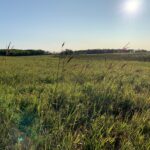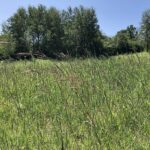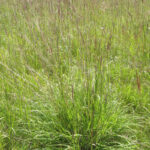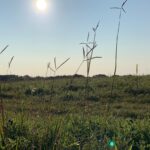Big Bluestem
Andropogon gerardii
General Description
Native grass. Big bluestem, which is sometimes referred to as turkey foot because of the seed head with 3 spikelets, is weakly rhizomatous. Big bluestem is a warm season, perennial bunchgrass with blue-green stems 4-8 ft tall. Long light green to blue-green leaves are plentiful at ground level and carry up the stem. Fall color is maroonish-tan.
More drought tolerant than most warm-season perennial grasses. It tends to be taller than the other species (1-2.5 meters tall) and was at one time very abundant. It can still get quite aggressive when it’s established in a favorable, undisturbed location, but overgrazing and land destruction have reduced it to mere patches of its former range. Part of the problem is that cattle love it so much – some ranchers refer to it as “ice cream for cows” – and it cannot take concentrated grazing; the seasonal grazing of migratory bison is what it’s evolved to cope with.
Active management to maintain big bluestem stands is important as it is a desirable and palatable grass.
Type
Native grass.
Origin
Native to the Tall Grass Prairie (Manitoba).
Longevity
Long-lived.
Use
Reclamation, hay, pasture.
Optimal Time of Use
Summer, fall. Big bluestem begins growing later in the spring. Graze later in the summer (or dormant) to maintain stand longevity and production. At least 4-8 in (10-20 cm) of standing stubble should remain after grazing. Because it a warm season perennial it works well in a forage mixture that complements cool-season forage growth to have it coming into production when the cool season perennials may be dormant mid-summer.
Recovery After Use
Big bluestem requires warm temperatures for rapid regrowth. Big bluestem regrowth is also dependent on moisture, the previous year’s production level, intensity of defoliation and root energy reserves. Better adapted for rotational grazing that doesn’t allow for close, continuous grazing. Grazing should be deferred on seeded lands for at least two growing seasons to allow for full stand establishment.
Palatability/Nutritional Value
Big bluestem is highly palatable. It is preferred in native stands to other grasses. Big bluestem crude protein range from 7-12% during summer and is highly nutritious when vegative. Forage quality and palatability drops in the fall.
Palatable over a wider range of maturities than switchgrass. It is extremely palatable to the point of being at a high risk for overgrazing because it is so palatable.
Drought Tolerance
Moderate drought tolerance.
Flooding Tolerance
Tolerates saturated soils for approximately one to two weeks in the spring. Thrives with even growing season moisture.
Winter Hardiness
Good winter hardiness. Intense defoliation or clipping below 4-8 in (10-20 cm) compromises big bluestem’s winter hardiness.
Soil Texture Preference
Big bluestem grows under a wide range of conditions. It is highly suited to moist, well drained, fertile loam soils. Warm growing conditions are critical for big bluestem growth.
Erosion Control
Moderate ability to contribute to erosion control mainly due to ability to hold soil and protect from wind erosion.
Salinity Tolerance
Slight saline tolerance.
Acidity Tolerance
Big bluestem tolerates soil pH as low as 6.0.
Alkalinity Tolerance
Low to moderate tolerance.
Seeds per kg
317,000 seeds/ kg (144,000 seeds/lb)
Suggested Mixtures
As a pure stand or with other native warm or select less competitive cool season native species. Tame mix suggestions include tame buchgrasses, birdsfoot trefoil and alfalfa.
Ease of Establishment
Big bluestem has fair seedling vigor. Weed control and early spring seeding is important for decent establishment. Refraining from harvesting during the year of establishment and even the second year will benefit the stands vigour in the long run. Not suitable for fall dormant seeding.
Competitiveness
Big bluestem is a poor competitor during establishment or when grazed due to its high palatability and slow regrowth. Big bluestem competes poorly with tame grasses. It is a decreaser species in native grasslands.
Management Considerations
A spring dormant season burning stimulates new growth of big bluestem in its primary area of adaptation and decreases competition of cool season plants already growing. Manage cool season grasses to decrease competition for big bluestem when appropriate.
Dryland Forage Species Adaptation Tool, USDA Plants Database, Manitoba Forage Adaptation and Comparison Guide
http://www.omafra.gov.on.ca/CropOp/en/indus_misc/biomass/tgp.html



